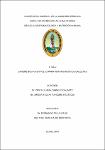Sangre bovina en polvo para fortificación de galletas

View/
Date
2017Author
Chang Escalante, Isis Jhuliana
Panduro Reátegui, Ximena Yulexy
Metadata
Show full item recordAbstract
El objetivo de este trabajo fue evaluar la composición centesimal y atributos sensoriales de galletas fortificadas con sangre bovina en polvo. La sangre obtenida del matadero municipal fue deshidratada en deshidratador de bandejas a 70°C y 1 cm de espesor de la sangre en cada bandeja. La sangre deshidratada tuvo alta concentración de proteínas y hierro, y la humedad después de 21 horas de deshidratación estuvo por debajo del 10%. Las concentraciones de la sangre en la formulación de las galletas fueron 0, 3, 7 y 10%, con relación al peso de la harina de trigo. En la composición centesimal, los tratamientos obtuvieron valores por debajo de 5.2% y 2.5% de humedad y cenizas, respectivamente. El contenido de proteína aumenta a mayor fortificación, alcanzando valores por encima del 10%. El contenido de grasa disminuyó a partir de 7% de fortificación, el cual fue concomitante con la disminución del valor calórico. Mientras que el contenido de carbohidratos varió de 64% a 66%. Los valores de hierro aumentaron a mayor fortificación, pero no hubo diferencias (P > 0.05) entre 7% y 10% de fortificación (36.1 mg Fe/100 g y 43.8 mg Fe/100 g, respectivamente). A través de la técnica sensorial de Análisis Descriptivo Cuantitativo (ADC), los jueces entrenados usaron 23 atributos para describir al producto, siendo que no hubo diferencias significativas en la mayoría de ellos, excepto para los atributos apariencia oscura y quemada, los cuales fueron altos para el 10% de fortificación, y para la textura suave, en el cual no hubo una tendencia clara para este atributo. Por lo tanto, el uso de sangre bovina en polvo puede ser una estrategia para combatir la desnutrición y anemia, observado en tasas alarmantes en países que incluye el Perú. The aim of this work was to evaluate centesimal composition and sensory attributes of cookies fortified with powdered bovine blood. The blood was obtained from a slaughterhouse and dehydrated in a tray dehydrator. It was used a temperature of dehydration of 70°C and 1 cm of thickness of blood in the tray. The blood dehydrated had high concentration of proteins and iron, and the moisture after 21 hours of dehydration was below 10%. The concentrations of the powdered blood in the formulation of cookies were 0, 3, 7, and 10%, based on the weight of wheat flour. In the centesimal composition, the treatments obtained values below 5.2% and 2.5%, for moisture and ash, respectively. The protein content increased when the percentage of fortification was higher, reaching values above 10%. The fat content decreased from 7% of fortification, and it was concomitant with the decrease of the calorific value at the same percentage of fortification, whereas the carbohydrate content varied from 64 to 66%. The iron values increased at high fortification, but there were no differences (P > 0.05) at 7% and 10% (36.1 mg Fe/100 g and 43.8 mg Fe/100 g, respectively). Through the sensory technique of Quantitative Descriptive Analyses (QDA), the trained judges used 23 attributes to describe the product, and there were no statistical differences in most of them, except to dark and burned appearance, which were high at 10% of fortification, and for smooth texture, which there was no clear trend for this attribute. Furthermore, the use of powdered bovine blood could be a strategy to combat malnutrition and anemia, observed in alarming numbers in countries that include Peru.
Collections
- Tesis [191]
The following license files are associated with this item:

